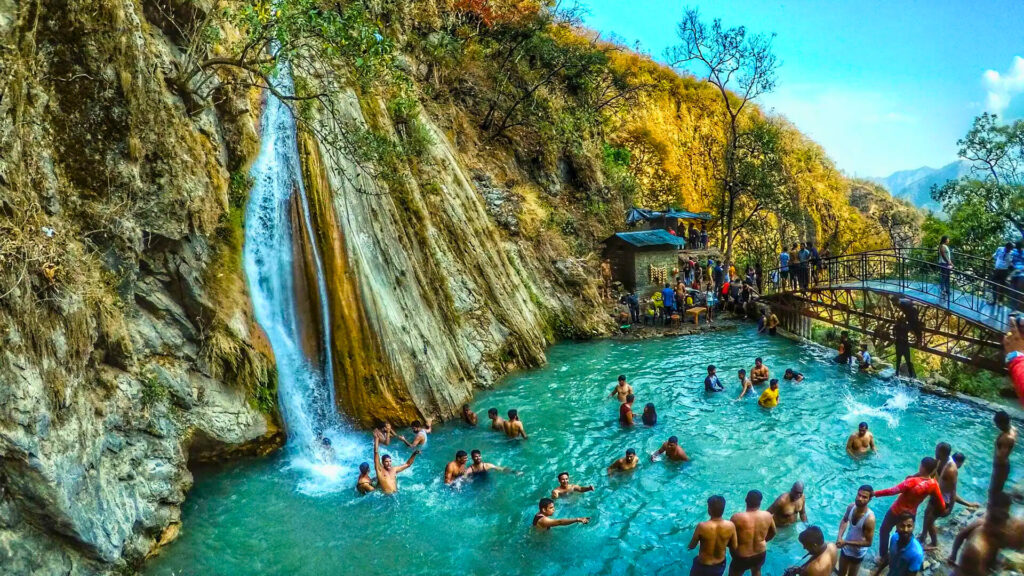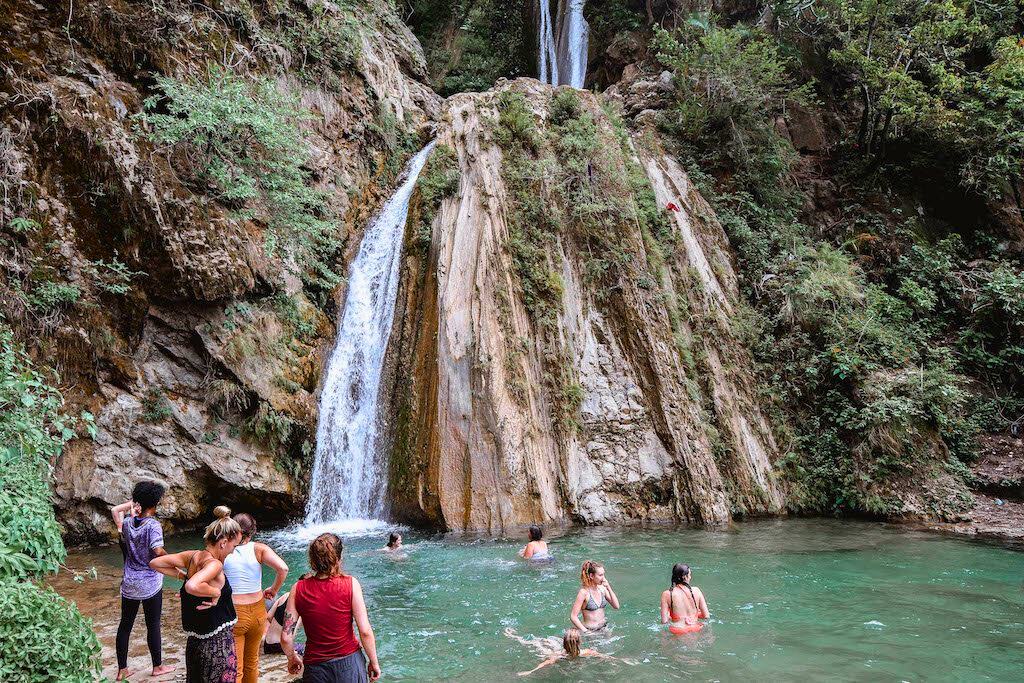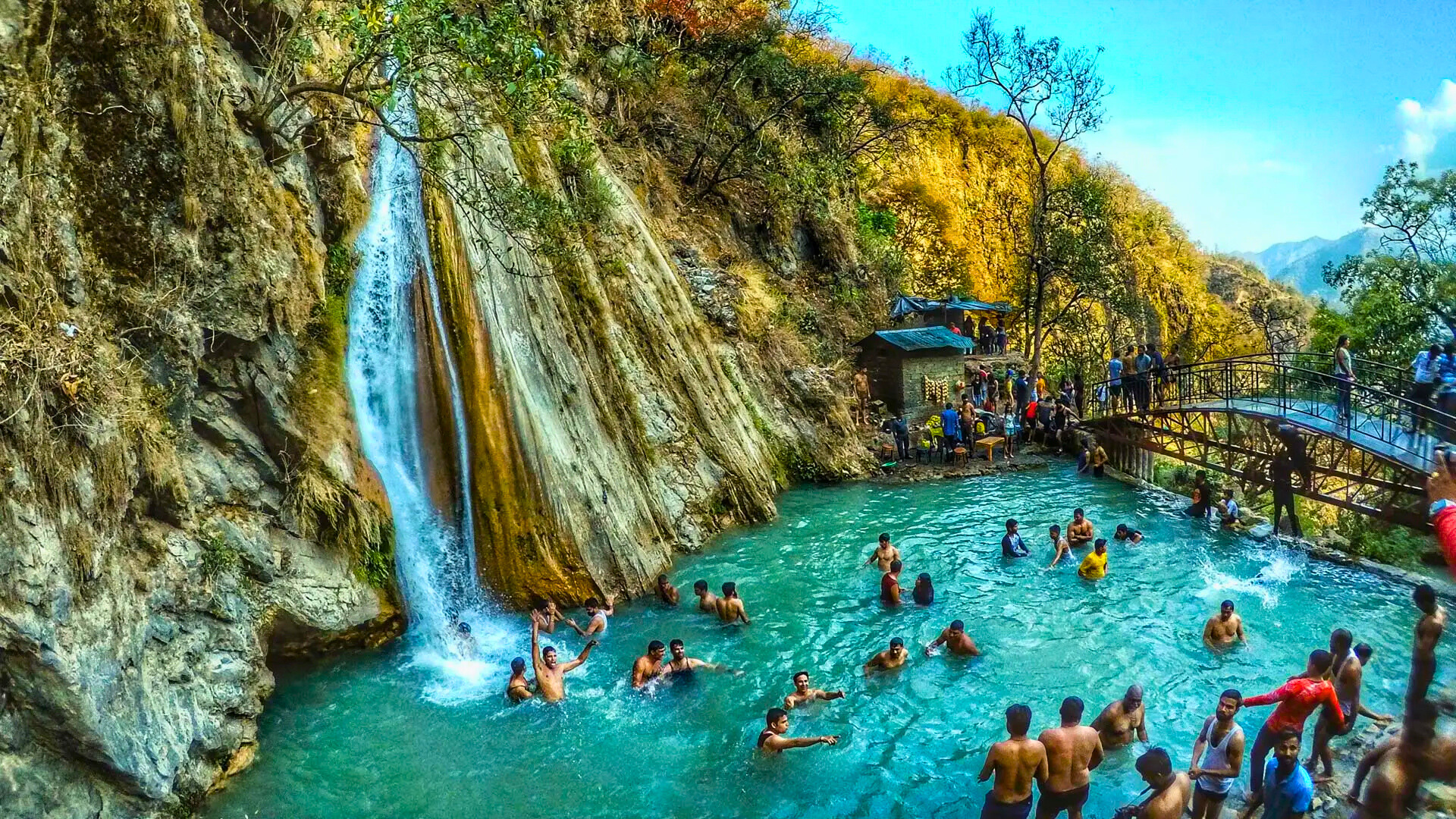Neer Garh Waterfall: A Hidden Gem in Rishikesh
Nestled in the heart of the Himalayan foothills, Neer Garh Waterfall is a picturesque retreat near Rishikesh, Uttarakhand. Renowned for its natural beauty and tranquil surroundings, this waterfall is a popular destination for nature lovers, adventure enthusiasts, and travelers seeking solace from the hustle and bustle of city life.
Location and Accessibility
Located approximately 5 kilometers from the bustling center of Rishikesh, Neer Garh Waterfall is easily accessible by road. Visitors often choose to trek the final stretch, which takes them through scenic pathways surrounded by dense forests and diverse flora. The trek itself is a highlight, offering glimpses of local wildlife and breathtaking views of the surrounding hills.
The Waterfall and Its Beauty
Neer Garh Waterfall is a multi-tiered cascade that flows down rocky cliffs, creating natural pools at various levels. The crystal-clear water originates from mountain streams and is refreshingly cool, especially during the summer months. Visitors can take a dip in the pools or simply sit by the water, soaking in the serene ambiance. The sound of the cascading water combined with the chirping of birds creates a peaceful environment, making it an ideal spot for meditation or relaxation.
Nearby Attractions to Neer Garh Waterfall, Rishikesh
Neer Garh Waterfall is surrounded by various attractions that reflect the natural, spiritual, and adventurous essence of Rishikesh. Here’s a list of must-visit places near the waterfall:
1. Laxman Jhula (Approx. 5 km)
One of the iconic landmarks of Rishikesh, Laxman Jhula is a 450-foot-long suspension bridge over the Ganges River. According to mythology, it is believed that Lord Laxman crossed the river using a jute rope at this spot. The bridge offers stunning views of the Ganges and the surrounding hills. It’s also a bustling hub with shops selling local handicrafts, jewelry, and snacks.
2. Ram Jhula (Approx. 6 km)
Similar to Laxman Jhula, Ram Jhula is another iron suspension bridge located downstream. It connects the Shivananda Ashram area to the Swarg Ashram area and offers a panoramic view of the river and its ghats. The area around Ram Jhula is known for its ashrams, yoga centers, and street-side eateries serving delicious local food.
3. Parmarth Niketan Ashram (Approx. 7 km)
Parmarth Niketan is one of the largest ashrams in Rishikesh, attracting thousands of visitors for yoga, meditation, and spiritual programs. The ashram is famous for its serene atmosphere and the evening Ganga Aarti, which is a spiritual ceremony held on the riverbank. It’s a soul-stirring experience that shouldn’t be missed.
4. Beatles Ashram (Approx. 8 km)
Formerly known as the Maharishi Mahesh Yogi Ashram, this is where The Beatles stayed in the late 1960s to study Transcendental Meditation. The ashram is now a heritage site with graffiti art and abandoned structures, attracting fans of the legendary band and those interested in its historical significance. The location is peaceful and perfect for photography and reflection.
5. Triveni Ghat (Approx. 7 km)
Triveni Ghat is one of the most significant ghats in Rishikesh, known for its spiritual ambiance. Pilgrims gather here for a dip in the holy Ganges, as it is believed to cleanse one of sins. The evening Aarti at Triveni Ghat, accompanied by devotional songs and the sight of floating lamps, is a mesmerizing experience.
6. Patna Waterfall (Approx. 8 km)
If you enjoyed Neer Garh Waterfall, you might also love Patna Waterfall. Located on the Neelkanth Road, this serene waterfall is named after the nearby Patna village. The short trek to the waterfall is surrounded by lush greenery, and it’s a quieter alternative to Neer Garh for those seeking solitude.
7. Shivpuri (Approx. 18 km)
Shivpuri is a hub for adventure activities such as river rafting, camping, kayaking, and cliff jumping. It is particularly famous for its rafting expeditions on the Ganges, which range from beginner-friendly stretches to challenging rapids. The riverside camps at Shivpuri provide a unique outdoor experience.
8. Neelkanth Mahadev Temple (Approx. 20 km)
Perched at an altitude of 1,330 meters, the Neelkanth Mahadev Temple is one of the most revered shrines dedicated to Lord Shiva. Surrounded by dense forests, this temple holds great mythological importance, as it is believed to be the place where Lord Shiva drank poison during the churning of the ocean (Samudra Manthan).
9. Rajaji National Park (Approx. 25 km)
For wildlife enthusiasts, Rajaji National Park offers an opportunity to explore diverse flora and fauna. The park is home to elephants, tigers, leopards, deer, and various bird species. Visitors can enjoy jungle safaris and nature walks in this serene environment.
10. Kaudiyala (Approx. 36 km)
Located further upstream on the Ganges, Kaudiyala is a peaceful village known for its scenic beauty and adventure sports. It is a starting point for many river rafting expeditions and offers a chance to witness the raw beauty of the Himalayan terrain.
Tips for Visitors
- Footwear: Comfortable trekking shoes are recommended, as the path to the waterfall can be rocky and slippery in places.
- Clothing: Carry lightweight, breathable clothing, and keep an extra set if you plan to swim in the pools.
- Essentials: Bring water bottles, sunscreen, and insect repellent. While food stalls are available, carrying light snacks is advisable.
- Respect Nature: Avoid littering and ensure the natural beauty of the waterfall is preserved.
For more information you can visit : click here


The Natural Splendor
Neer Garh Waterfall is a multi-tiered cascade that flows through rocky cliffs and dense forest cover. The water streams down from the mountains, forming a series of pools at different levels. These natural pools offer visitors the chance to dip their feet or swim in the refreshing, crystal-clear waters.
The first tier of the waterfall is the most accessible and often the most crowded. However, for those seeking a more tranquil experience, continuing the trek upward to the second or third tier is highly recommended. The upper levels are quieter, offering a serene environment surrounded by untouched natural beauty. The cool water, coupled with the rustling of leaves and chirping of birds, creates an idyllic setting.
Flora and Fauna
The region around Neer Garh Waterfall is rich in biodiversity. The dense vegetation comprises various species of trees, shrubs, and wildflowers, adding to the vibrancy of the landscape. The trek to the waterfall allows visitors to witness the raw beauty of the Himalayan foothills, with towering sal trees, bamboo groves, and climbers adorning the path.
The area is also home to a variety of fauna. It’s not uncommon to spot monkeys, butterflies, and a wide array of birds. Birdwatchers will find the site particularly appealing, as the waterfall attracts several species of Himalayan and migratory birds.
The Adventure Experience
For adventure seekers, the trek to Neer Garh Waterfall provides just the right amount of thrill. The trail involves navigating rocky paths, crossing small streams, and occasionally climbing steep sections. The terrain, though not overly challenging, requires a basic level of fitness and sturdy footwear.
Photography enthusiasts also find this spot to be a haven. The interplay of sunlight and water creates a shimmering effect, making the falls a picturesque subject for nature photography. Many visitors capture their experience amidst the greenery, rocks, and sparkling water.
The waterfall is also a popular stop for trekkers who are exploring the larger Rishikesh area. It provides a peaceful break from the more crowded attractions in the town.
Cultural and Spiritual Significance
Rishikesh is a place deeply rooted in spirituality, and the natural wonders here often hold a special place in the hearts of locals and visitors alike. Neer Garh Waterfall is no exception. While it is primarily a nature spot, its serene and calming environment resonates with the spiritual ethos of Rishikesh. Many visitors find the sound of the flowing water meditative, making it a great place to practice yoga or simply sit in contemplation.
The waterfall also serves as a reminder of the close relationship between the people of Rishikesh and their natural surroundings. The locals value and protect this pristine environment, understanding its importance not only for tourism but also for the region’s ecological balance.
Best Time to Visit
Neer Garh Waterfall can be visited year-round, but the best time to experience its full glory is during the monsoon season (July to September). During this time, the waterfall is at its peak flow, creating a stunning and powerful cascade. However, visitors should exercise caution during the monsoon as the trails can become slippery and water levels unpredictable.
The months of October to February are also ideal, as the weather remains pleasant, and the water is cool and inviting. Summers (March to June) can be hot in Rishikesh, but the cool waters of the falls provide a refreshing escape from the heat.
Sustainability and Conservation
As a natural treasure, Neer Garh Waterfall demands efforts for its conservation. The increasing footfall of tourists has led to concerns about littering and pollution in the area. Responsible tourism practices are essential to preserve the waterfall’s beauty for future generations.
Visitors are encouraged to carry reusable water bottles, avoid single-use plastics, and dispose of waste responsibly. Additionally, trekkers should stay on designated trails to minimize damage to the fragile ecosystem. Several local initiatives and volunteer groups work towards maintaining the cleanliness of the site, but collective effort is required to ensure its sustainability.
Tips for Visitors
- Carry Essentials: Comfortable footwear, water, snacks, and sunscreen are must-haves for the trek. If you plan to swim, bring a change of clothes and a towel.
- Start Early: To avoid crowds, it’s best to visit the waterfall early in the morning.
- Safety First: The rocks around the waterfall can be slippery. Exercise caution, especially if you’re climbing to the higher tiers.
- Respect Nature: Avoid littering and maintain the sanctity of the place.
- Camera Ready: Don’t forget to bring a camera or a smartphone to capture the mesmerizing beauty of the falls.
FAQs About Neer Garh Waterfall
1. Where is Neer Garh Waterfall located?
Neer Garh Waterfall is located approximately 5–6 kilometers from the center of Rishikesh in the state of Uttarakhand, India. It is near the Laxman Jhula area and is easily accessible by road followed by a short trek.
2. How can I reach Neer Garh Waterfall?
You can reach the waterfall by:
- Hiring a taxi or renting a scooter from Rishikesh to the base point.
- Trekking for about 20–30 minutes from the base to reach the first tier of the waterfall. For those who enjoy walking, it is possible to trek directly from Laxman Jhula or Tapovan, which takes around an hour.
3. What is the best time to visit Neer Garh Waterfall?
- Monsoon (July to September): The waterfall is at its peak flow, making it the most stunning time to visit, though the trails can be slippery.
- Winter (October to February): Pleasant weather and moderate water flow make this a great time for a visit.
- Summer (March to June): A refreshing escape from the heat, though the water flow might be less robust than during the monsoon.
4. Is there an entry fee for Neer Garh Waterfall?
Yes, there is a nominal entry fee, usually around INR 20–50 per person. The fee is collected by local authorities for maintaining the area.
5. Is Neer Garh Waterfall suitable for families and children?
Yes, the waterfall is family-friendly. However:
- The trek to the higher tiers may be challenging for small children or elderly visitors.
- Supervise children near the water and slippery rocks.
6. Can I swim in Neer Garh Waterfall?
Yes, visitors can swim or take a dip in the natural pools formed by the waterfall. The water is clear and refreshing, especially during the summer. However, exercise caution and avoid deep areas if you are not a confident swimmer.
7. What should I carry when visiting Neer Garh Waterfall?
Here are some essentials:
- Comfortable trekking shoes.
- Water bottle and light snacks.
- Sunscreen and a hat for protection from the sun.
- A towel and change of clothes if you plan to swim.
- A camera or smartphone for capturing the beauty of the falls.
8. Are there any food or drink options near the waterfall?
There are small local shops and stalls near the base and along the trail that sell snacks, water, and tea. However, it’s a good idea to carry your own refreshments, especially if you plan to trek to the higher tiers.
9. Is the trek to Neer Garh Waterfall difficult?
The trek is moderately easy and suitable for most fitness levels. The trail is well-marked but involves some rocky and uneven sections. Proper footwear is recommended, and caution should be exercised during the monsoon season due to slippery paths.
10. How many tiers does the waterfall have?
Neer Garh Waterfall has three main tiers. The first tier is the most accessible and crowded. The second and third tiers, though requiring more trekking, are quieter and offer a more serene experience.
Conclusion
Neer Garh Waterfall is more than just a tourist spot; it is a slice of paradise hidden in the heart of Rishikesh. Whether you are an adventure enthusiast, a nature lover, or someone seeking peace and solitude, this waterfall has something to offer everyone. Its serene ambiance, coupled with the thrill of trekking and the refreshing waters, makes it a must-visit destination.
In a town known for its spiritual heritage and natural wonders, Neer Garh Waterfall stands out as a perfect blend of both. It serves as a reminder of the beauty and tranquility that nature offers, encouraging visitors to pause, breathe, and connect with their surroundings. A visit to this enchanting waterfall is not just an excursion; it’s an experience that stays with you long after you’ve left the cascading waters behind.




Leave a Reply